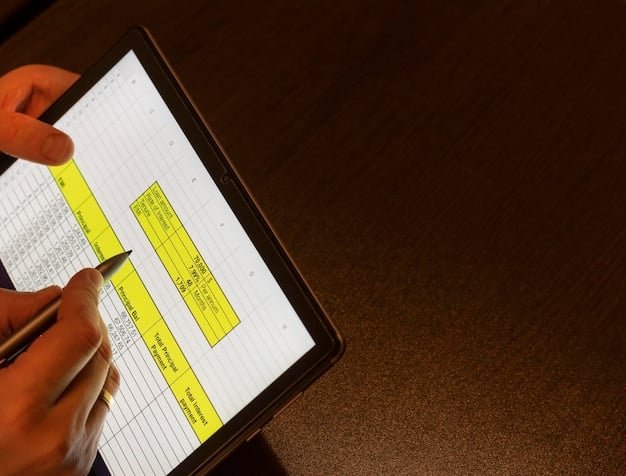Dispute Credit Report Errors: Boost Your Score by 50 Points

Disputing credit report errors involves carefully reviewing your credit reports from Experian, Equifax, and TransUnion, identifying inaccuracies, and submitting formal dispute letters with supporting documentation to each credit bureau to correct the information and improve your credit score.
Is your credit score lower than it should be? Inaccurate information on your credit report could be the culprit. This guide will show you how to dispute errors effectively: A step-by-step guide to removing inaccurate information and boosting your credit score by 50 points.
Understanding Your Credit Report and Its Impact
Your credit report is a detailed record of your credit history. It includes information about your payment history, credit accounts, loans, and any bankruptcies or liens. This report significantly impacts your ability to obtain loans, mortgages, and even rent an apartment.
Errors on your credit report can negatively affect your credit score, leading to higher interest rates or even denial of credit applications. Therefore, it’s essential to review your credit report regularly and dispute any inaccuracies you find.
Why Regular Credit Report Reviews are Essential
Regularly checking your credit report helps you identify errors, detect potential identity theft, and monitor your credit health. It’s recommended to review your credit reports from all three major credit bureaus at least once a year.
Common Types of Credit Report Errors
Credit report errors can take many forms, from incorrect personal information to inaccurate account details. Common errors include:
- Incorrect personal information (e.g., name, address, Social Security number)
- Inaccurate account details (e.g., credit limits, balances, payment history)
- Closed accounts listed as open
- Accounts listed multiple times
- Fraudulent accounts opened in your name
Identifying and disputing these errors is essential to maintaining a healthy credit score. Ignoring them can lead to long-term financial consequences.

In conclusion, understanding your credit report and its impact is the first step towards improving your credit score. Regular reviews and prompt dispute resolution can help you maintain an accurate credit history.
Obtaining Your Credit Reports from the Major Bureaus
To begin the process of disputing errors, you must first obtain your credit reports from the three major credit bureaus: Experian, Equifax, and TransUnion. Each bureau may have slightly different information, so it’s essential to check all three.
You’re entitled to a free credit report from each bureau every 12 months through AnnualCreditReport.com. This service is authorized by federal law and ensures you can access your credit information without charge.
How to Access Your Free Credit Reports
You can request your free credit reports online, by phone, or by mail. The easiest method is to visit AnnualCreditReport.com and follow the instructions. You’ll need to provide your personal information, such as your name, address, Social Security number, and date of birth.
Understanding the Information on Each Report
Once you receive your credit reports, take the time to carefully review each section. Pay close attention to personal information, account details, public records, and credit inquiries. Make sure all the information is accurate and up-to-date.
Alternatives to AnnualCreditReport.com
While AnnualCreditReport.com is the official source for free annual credit reports, you can also obtain your credit reports through other means, such as:
- Credit monitoring services
- Credit card issuers
- Lenders
However, be cautious of services that require a subscription or charge a fee. Always read the terms and conditions carefully before providing your personal information.
Obtaining your credit reports from all three major bureaus is a crucial step in the dispute process. It allows you to identify errors and take steps to correct them promptly.
Identifying Inaccurate Information on Your Credit Reports
After obtaining your credit reports, the next step is to meticulously review each one and identify any inaccuracies. This process requires attention to detail and a thorough understanding of your credit history.
Start by verifying your personal information, such as your name, address, Social Security number, and date of birth. Then, move on to reviewing your account details, payment history, and any public records or credit inquiries.

Checklist for Reviewing Your Credit Reports
To ensure you don’t miss any errors, use a checklist to guide your review. Your checklist should include:
- Verifying personal information
- Confirming account details (e.g., credit limits, balances, payment history)
- Checking for duplicate accounts
- Identifying accounts you don’t recognize
- Reviewing public records and credit inquiries
Tools for Organizing Your Findings
Organizing your findings is essential for preparing your dispute letters. Use tools such as spreadsheets or note-taking apps to keep track of the errors you identify. Include details such as the credit bureau, account number, type of error, and supporting documentation.
By carefully reviewing your credit reports and organizing your findings, you’ll be well-prepared to dispute any inaccuracies and improve your credit score.
Preparing Your Dispute Letters to Each Credit Bureau
Once you’ve identified errors on your credit reports, the next step is to prepare dispute letters to each credit bureau. Each letter should clearly explain the error, provide supporting documentation, and request that the bureau investigate and correct the information.
It’s essential to send separate letters to each bureau, as they may not share information with each other. Be sure to keep copies of your letters and any supporting documentation for your records.
Essential Information to Include in Your Dispute Letters
Your dispute letters should include the following information:
- Your full name and address
- Your Social Security number and date of birth
- The name of the credit bureau you’re disputing with
- The account number and specific details of the error
- A clear explanation of why the information is inaccurate
- Copies of supporting documentation (e.g., bank statements, payment records)
- A request for the bureau to investigate and correct the information
Be concise and factual in your explanations. Avoid emotional language or personal opinions. Focus on the facts and provide clear evidence to support your claims.
Tips for Writing Effective Dispute Letters
To write effective dispute letters, consider the following tips:
- Use a professional tone and format
- Be clear and concise in your explanations
- Provide specific details about the error
- Include copies of supporting documentation
- Keep a copy of your letter for your records
- Send your letter via certified mail with return receipt requested
Sample Dispute Letter Template
Here’s a sample dispute letter template you can use as a starting point:
[Your Name]
[Your Address]
[City, State, Zip Code]
[Date]
[Credit Bureau Name]
[Credit Bureau Address]
[City, State, Zip Code]
Subject: Credit Report Dispute – Account Number [Account Number]
Dear [Credit Bureau Name],
I am writing to dispute inaccurate information on my credit report. I recently obtained a copy of my credit report and found the following error:
[Describe the Error]
This information is inaccurate because [Explain Why]. I have attached copies of supporting documentation to verify my claim.
I request that you investigate this matter and correct the inaccurate information as soon as possible. Please send me a copy of the updated credit report once the correction has been made.
Thank you for your prompt attention to this matter.
Sincerely,
[Your Signature]
[Your Typed Name]
By carefully preparing your dispute letters and providing clear evidence to support your claims, you can increase your chances of successfully disputing errors and improving your credit score.
Submitting Your Dispute Letters and Tracking Their Progress
After preparing your dispute letters, the next step is to submit them to each credit bureau via certified mail with return receipt requested. This ensures you have proof that the bureau received your letter.
Once the bureau receives your dispute letter, they have 30 days to investigate the matter. During this time, they’ll contact the creditor or data furnisher to verify the information. They must then report the results of their investigation to you in writing.
How to Send Your Letters via Certified Mail
To send your letters via certified mail, follow these steps:
- Visit your local post office
- Fill out a certified mail form
- Attach the form to your envelope
- Request a return receipt
- Pay the required postage
Keep the receipt and return receipt for your records. This will serve as proof that the bureau received your dispute letter.
Understanding the Credit Bureau’s Investigation Process
The credit bureau’s investigation process typically involves contacting the creditor or data furnisher to verify the information in question. The creditor must then provide evidence to support their claim. If the creditor fails to respond or cannot provide sufficient evidence, the bureau must remove the inaccurate information from your credit report.
Following Up on Your Disputes
If you don’t receive a response from the credit bureau within 30 days, follow up with them to inquire about the status of your dispute. You can contact them by phone or mail. Be sure to have your tracking number and dispute letter on hand when you call.
Submitting your dispute letters via certified mail and tracking their progress is essential for ensuring your disputes are handled properly. It also provides you with documentation in case you need to escalate the matter further.
Understanding the Results of Your Disputes and Next Steps
After the credit bureau completes its investigation, it will send you a written report detailing the results of your dispute. This report will indicate whether the bureau corrected the inaccurate information, verified the information as accurate, or determined that the information was unverified.
If the bureau corrected the inaccurate information, review your updated credit report to ensure the changes were made correctly. If the bureau verified the information as accurate or determined that it was unverified, you have the right to appeal their decision or take further action.
Interpreting the Credit Bureau’s Response
The credit bureau’s response will typically include one of the following outcomes:
- Correction: The bureau corrected the inaccurate information on your credit report.
- Verification: The bureau verified the accuracy of the disputed information.
- Unverified: The bureau was unable to verify the accuracy of the disputed information and removed it from your credit report.
Options for Appealing the Credit Bureau’s Decision
If you disagree with the credit bureau’s decision, you have the right to appeal. You can appeal by sending a written request to the bureau, providing additional evidence to support your claim. The bureau must then reinvestigate the matter and provide you with a new decision.
Other Actions to Take if the Error Persists
If the error persists after appealing the credit bureau’s decision, you have several other options:
- File a complaint with the Consumer Financial Protection Bureau (CFPB)
- Contact the creditor or data furnisher directly
- Consider hiring a credit repair company
- Consult with an attorney
These options can help you resolve the issue and ensure your credit report is accurate.
Understanding the results of your disputes and taking appropriate next steps is crucial for protecting your credit score. Don’t give up until the inaccurate information is corrected or removed from your credit report.
| Key Point | Brief Description |
|---|---|
| 🔍 Regular Reviews | Check credit reports annually for errors. |
| 📝 Dispute Letters | Send certified letters with supporting documents. |
| ⏱️ Tracking Progress | Follow up if no response within 30 days. |
| ✅ Corrected Info | Ensure updates are accurate after dispute. |
[FAQ Section]
Frequently Asked Questions
▼
You should check your credit report at least once a year. Checking more frequently allows you to catch errors and potential fraud sooner, minimizing the impact on your credit score.
▼
If you find an error, gather supporting documents and send a dispute letter to the credit bureau. Clearly explain the error and provide evidence to support your claim for a thorough investigation.
▼
Credit bureaus typically have 30 days to investigate a dispute. During this time, they contact the creditor or data furnisher to verify the information, ensuring a fair and timely resolution.
▼
Include your full name, address, Social Security number, the name of the credit bureau, the account number of the error, and a clear explanation of why the information is inaccurate, along with supporting documents.
▼
No, disputing an error should not hurt your credit score. Disputing allows you to correct inaccuracies, which can ultimately improve your credit score by ensuring it’s based on accurate information.
Conclusion
By following this step-by-step guide to dispute errors effectively: A step-by-step guide to removing inaccurate information and boosting your credit score by 50 points, you can take control of your credit health and ensure your credit report accurately reflects your financial history, ultimately leading to a better credit score and improved financial opportunities.





